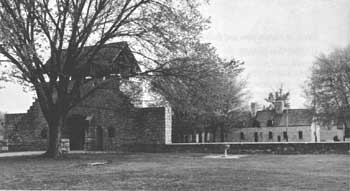






Survey of Historic Sites and Buildings
 |
FORT DE CHARTRES Illinois |
 |
| ||
Ownership and Administration. State of Illinois; Division of Parks and Memorials.
Significance. Fort de Chartres was one of France's most imposing fortifications in North America. Though never attacked, in the 18th century it served as the center of French civil and military government of the Illinois country and reflected the aspirations of Frenchmen in the Mississippi Valley.
The present partially reconstructed fort is on the site of the third outpost on the Mississippi to bear the name de Chartres, and is preserved as an Illinois State Park. A temporary fort was constructed in 1720. Construction of a permanent fort was begun in 1753 and largely completed 3 years later. The fort's massive stone walls, 18 feet high and more than 2 feet thick, enclosed two long barracks, a guardhouse, two officers' quarters, a powder magazine, a kitchen, and outbuildings—all arranged around a 4-acre parade ground. The fort could have accommodated a garrison of 400 men, but less than half that number were usually assigned.
Despite the formal ending of French sovereignty in America in 1763, a French garrison continued to occupy the fort until 1765, when British troops moved in and renamed it Fort Cavendish. It served as the center of British rule of the Illinois country until 1772, when it was evacuated and destroyed.
 |
| Reconstructed gateway and museum at Fort de Chartres, Illinois. In the 18th century, the fort was the center of French civil and military government in the Illinois country. |
Present Appearance. The State of Illinois acquired the site in 1915, and since then has reconstructed parts of the fort, including the gateway and the combined guardhouse and chapel. The magazine, which is original, has also been restored. Of even more interest and importance are the extensive foundation remains that have been exposed by archeologists. They present a vivid picture of the nature of the fort when it housed French, and later English, garrisons. A small museum, on the foundations of the fort's original storehouse, displays various artifacts. Standing in a fertile valley free from modern encroachments, the lonely fort is an impressive symbol of the one-time widespread holdings of France in the heartland of North America. [17]
NHL Designation: 10/09/60
 |
 |
http://www.cr.nps.gov/history/online_books/explorers-settlers/sitec15.htm
Last Updated: 22-Mar-2005